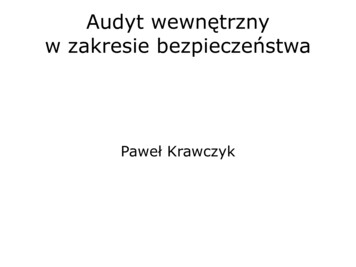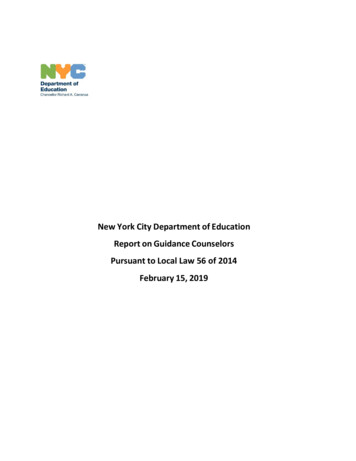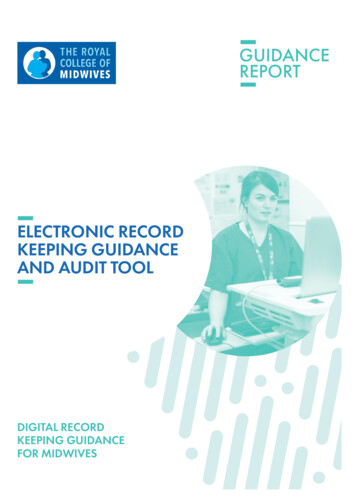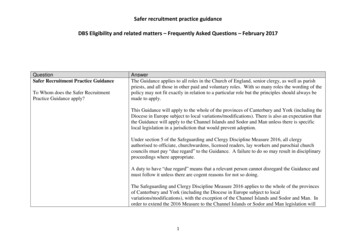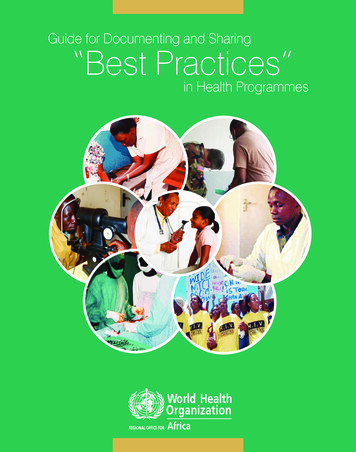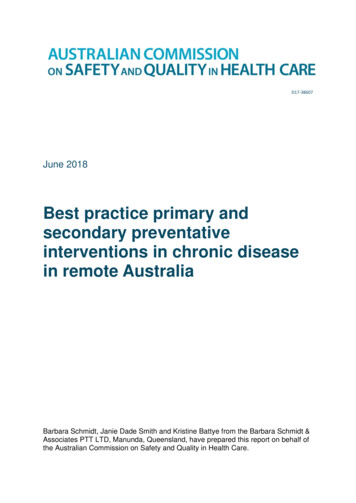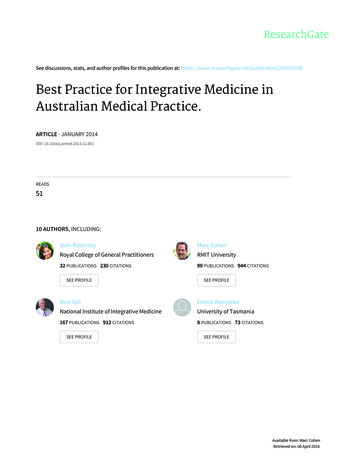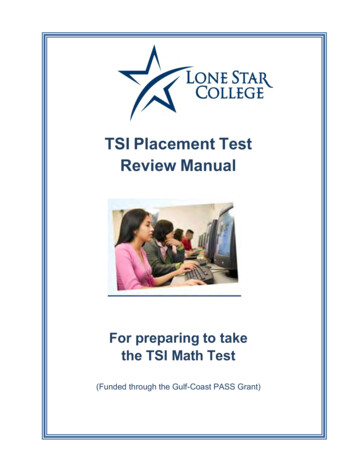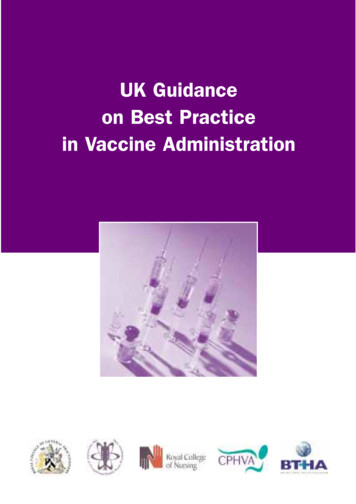
Transcription
UK Guidanceon Best Practicein Vaccine Administration
Copyright 2001Applications for reproduction should be made to Shire Hall Communications,3 Olaf Street, London, W11 4BEISBN 0-9541497-0-XPublished by Shire Hall CommunicationsFor additional copies please write to:The Vaccine Administration TaskforceShire Hall CommunicationsPO Box 31580LondonW11 4YZThis initiative has been supported by an educational grant from GlaxoSmithKline2UK Guidance on Best Practice in Vaccine Administration
PrefaceThis guidance has been developed in the year 2001 after consultation with thefollowing contributors, who formed the Vaccine Administration Taskforce (VAT):Jane Chiodini, Travel Health and Immunisation Specialist Nurse; Chair, RoyalCollege of Nursing (RCN) Travel Health ForumGail Cotton, President, Association of Occupational Health Nurse Practitioners(AOHNP); Head of Occupational Health, Leicestershire Fire and Rescue ServiceFiona Genasi, Nurse Epidemiologist, Scottish Centre for Infection and EnvironmentalHealth (SCIEH)Karen Gupta, Independent Practice Nurse AdvisorMark Jones, Primary Care Policy and Practice Advisor, RCNDr George Kassianos, GP; Spokesperson on Immunisation, Royal College of GeneralPractitioners (RCGP); Primary Care Virology Group (PCVG)Judith Moreton, District Immunisation Co-ordinator, Oxfordshire Health AuthorityDr Jane Zuckerman, Travel Medicine Consultant; Director, Academic Centrefor Travel Medicine and Vaccines, Royal Free and University College MedicalSchool, LondonCarolyn Driver, Travel Health Specialist Nurse and Chair, British Travel HealthAssociation, has been instrumental in the development of this Guidance by authoringthe first draft and working alongside the VAT membersSpecial thanks also go to: Judith Moreton, who provided a copy of her work ‘Immunisation Handbook(Oxfordshire HA 2000)’, which assisted in the development of this guidance Dr Helen Bedford, Institute of Child Health, for her input and advice Jeannett Martin for her help drafting the section on ‘Consent’Foreword: Reference has been made to the United Kingdom Central Council forNursing, Midwifery and Health Visiting (UKCC) throughout this guidance. It isanticipated that the Nursing and Midwifery Council (NMC) will take over the role ofthe UKCC in April 2002 as well as taking on the work of the four national boards.UK Guidance on Best Practice in Vaccine Administration3
PrefaceThis guidance has been developed and endorsed by the following organisations:4 Association of Occupational Health Nurse Practitioners British Travel Health Association Community Practitioners and Health Visitors Association Royal College of General Practitioners Royal College of NursingUK Guidance on Best Practice in Vaccine Administration
ContentsIntroduction7Patient Group Directions and guidelines9Vaccine delivery, storage and stock control13Situations in which vaccination should be postponed or omitted19Consent21Preparing the vaccine equipment25Preparing and dealing with anxious people29Preparation of vaccine31Administration of vaccine33Choice of needle39Technique43Needle stick injuries49Disposal of needles, syringes and other waste products51Anaphylaxis and observation of patient after immunisation53Documentation55Local information form57Further reading59Further information sources61Appendix one63Appendix two67Index69UK Guidance on Best Practice in Vaccine Administration5
6UK Guidance on Best Practice in Vaccine Administration
IntroductionIntroductionThe principal aims of immunisation are threefold:1Introduction To protect the individual from infectious diseases, with associated mortality,morbidity and long term sequelae To prevent outbreaks of disease Ultimately to eradicate infectious diseases world-wide, as in the case of smallpoxNurses are now the major force in administering vaccinations not only within thechildhood immunisation programme but also increasingly in administering travelvaccines and in the annual influenza vaccination campaign. In agreeing to undertakethis work, nurses assume professional accountability and should ensure that theykeep up to date with all aspects of immunisation as outlined in the United KingdomCentral Council’s (UKCC) ‘Guidelines for Professional Practice’.2 A doctor whodelegates the task of immunisation to a nurse also has a responsibility to see thatthey are adequately trained and have the opportunity for regular updates.3BOX 1 2UKCC Guidelines for Professional Practice 1996“As a Registered Nurse you are personally accountable for your practiceand, in the exercise of your professional accountability, must .Maintain and improve your professional knowledge and competenceAcknowledge any limitations in your knowledge and competence and declineany duties or responsibilities unless able to perform them in a safe andskilled manner”UK Guidance on Best Practice in Vaccine Administration7
IntroductionImmunisation is a safe and highly effective method of preventing infectious disease.IntroductionSuccessful immunisation depends upon: Production of a safe and effective vaccine Maintenance of the cold chain during vaccine transportation and storage Injection into the correct anatomical site of an appropriate recipient Correct injection techniqueThis guidance outlines the step by step process and techniques involved in vaccination,from taking a vaccine out of the refrigerator to disposal of the needle and syringe atthe end of the procedure. The information provided should be used in conjunction withthe ‘Green Book’3 and will not therefore go into detail about individual vaccines.Nurses administering vaccines have a duty to be informed about each vaccine theyadminister and should use resources such as the ‘Green Book’ and the most recentSummary of Product Characteristics (SPC) or Patient Information Leaflet (PIL - foundwithin the vaccine packaging) to update themselves on information relating to aparticular disease area or product.Practices should also keep on file any Chief Medical Officer (CMO) or Chief NursingOfficer (CNO) correspondence regarding vaccination. Such correspondence shouldalways be shared at a Primary Care Organisation level (see section: ‘Furtherinformation sources’ for CMO and CNO contact details).Note: The information contained in this document will be relevant to a range of healthcareprofessionals including practice nurses, occupational health staff practitioners,health visitors, midwives and general practitioners (GPs). Throughout this documentthe healthcare professional administering the vaccine is referred to as the 'nurse'. Inaddition, the person receiving the vaccine i.e. the vaccinee, client, child or adult, willbe referred to as the 'patient'.References:1. Moreton J. Immunisation Handbook. UK: Oxfordshire Health Authority October 20002. United Kingdom Central Council for Nursing, Midwifery and Health Visiting.Guidelines for Professional Practice 19963. Salisbury D M, Begg N T. Department of Health, Immunisation Against InfectiousDisease. UK: HMSO 1996; Ch. 6: 178UK Guidance on Best Practice in Vaccine Administration
Patient Group Directions and guidelinesPatient Group Directions and guidelines1,2,3,4,5 Nurses must be aware of their legal position when administering a vaccine thathas not been individually prescribed by a doctor Since August 2000 Patient Group Directions (PGDs) have become a legalrequirement throughout the UK for any prescription-only medicine (POM)administered to a patient for whom no individual prescription exists2,4In the absence of legislation allowing nurses to prescribe a wide range of medicines –such as vaccines – alternative means have been developed to facilitate their supply andPatient Group Directionsand guidelinesadministration. During the 1990s nurses utilised the ad hoc system of ‘group protocols’which was given more credence by the Crown Report of 1998.6 Legislation wasintroduced in 2000,7,8,9 which made legal the supply and administration of medicines bynurses to undifferentiated patients under a formal agreement with a prescribing doctor.From August 9th 2000 such agreements became known as ‘Patient Group Directions’.PGDs are written agreements for the supply and administration of medicines togroups of patients who may not be individually identified before presentation fortreatment. They can be used for homogeneous patient groups where presentingcharacteristics and requirements are sufficiently consistent to be catered for by such anon-specific direction, although patients who can be identified before they need aspecific medicine should receive that medicine on a patient-specific basis.The law governing the use of PGDs applies UK-wide since August 2000. The law isequally applicable to all countries within the UK and national guidance is availablefrom the Department of Health (DoH)2 for England, the Welsh Assembly4 for Walesand the Scottish Executive Health Department5 in Scotland. However, the NorthernIreland Assembly has yet to issue guidance on the use of PGDs. Throughout the UK,PGDs should now be drafted to conform with the prevailing legislation. The RoyalCollege of Nursing produces additional guidance and explanation concerning the useof PGDs.3UK Guidance on Best Practice in Vaccine Administration9
Patient Group Directions and guidelinesNote that the law restricts the use of PGDs to the NHS or organisations providingcare for NHS patients as part of a contract with the NHS. It is expected thatlegislation will be brought forward to cover the independent sector, but in themeantime it is suggested that where PGDs might be considered to be in the bestinterests of patients, they should be drawn up and used in line with the nationalguidance. Nurses using PGDs in non-NHS settings should seek guidance from theirprofessional organisation/insurer. Practices should ensure that PGDs applicable to their own surgery/workplace arePatient Group Directionsand guidelinesin place – these should be drawn up by a multidisciplinary team at either PrimaryCare Organisation or Health Authority (HA) level (please refer to Appendix onefor a list of the information that must be included in a PGD) The PGD replaces a Group Protocol for the administration of a medicine – itdoes not replace the need for a protocol (guidelines) which describes the standardof care given in a particular situation (note: all outdated protocols should be kepton file for future reference) Guidelines are templates for a consultation and are necessary to demonstrate theway in which a particular surgery or clinic undertakes immunisation The information must be available for new or deputising staff to familiarisethemselves. In the event of a complaint or legal action the information will alsodemonstrate the standard of care that is given by a particular establishmentNote: This guidance can form part of a protocol for immunisation or travel clinics,as can any other written material which a practice or clinic chooses to useduring a consultation – further information is available in Appendix one.10UK Guidance on Best Practice in Vaccine Administration
Patient Group Directions and guidelinesBOX 2 1Black Triangle Vaccines These can be given under a PGD, provided they are used in accordancewith the schedules recommended by the Joint Committee on Vaccinationand Immunisation (JCVI)2 The PGD should state what action is to be taken if adverse events arereportedUnlicensed VaccinesPatient Group Directionsand guidelines Vaccines that do not have a product licence in the UK cannot be givenunder a PGD They should have a specific prescription signed by a doctorOff-Label Use of a Licensed VaccineA licensed product can be administered outside its licensed indicationsunder a PGD providing:2 Such use is justified by best practice The status of the product is clearly described There is acceptable clinical evidence for the use of the product for theintended indicationNote: Please refer to Appendix one for further information on PGDs and theinformation that should be included in them.Black Triangle Vaccines“The black triangle symbol indicates newly licensed medicines that are monitoredintensively by the Medicines Control Agency (MCA)/Committee on the Safety ofMedicines (CSM). Such medicines include those that have been licensed foradministration by a new route or drug delivery system, or for significant newindications which may alter the established risks and benefits of that drug.”10“For medicines showing the black triangle symbol, the MCA/CSM asks that allsuspected reactions (including those not considered serious) are reported through theUK Guidance on Best Practice in Vaccine Administration11
Patient Group Directions and guidelinesYellow Card scheme. An adverse reaction should be reported even if it is not certainthat the drug has caused it, or if the reaction is well recognised, or if other drugs aregiven at the same time.”10References:1. United Kingdom Central Council for Nursing, Midwifery and Health Visiting websiteDecember group%20directions%20(group%2Patient Group Directionsand guidelines0protocols).asp)2. Department of Health. Health Service Circular 2000/026 9 August 2000. NHSExecutive 20003. Royal College of Nursing. Patient Group Directions Guidance and Information.London: RCN 20014. The National Assembly for Wales. Review of Prescribing, Supply and Administrationof Medicines – Sale, Supply and Administration of Medicines by Health ProfessionalsUnder Patient Group Directions (PGD). CMOCNOCDOCSOCPhA-SALEMED3. 22December 20005. NHS in Scotland Health Department website June 2001. NHS HDL (2001)7(www.show.scot.nhs.uk)6. Department of Health. Review of prescribing supply and administration of medicines.Report on the supply and administration of medicines under group protocolarrangements. London: Department of Health. (Crown II part 1) 19987. Statutory Instrument. The Prescription only Medicines (Human Use) AmendmentOrder 2000. Statutory Instrument no.1917. London: HMSO 20008. Statutory Instrument. The Medicines (Sale or Supply)(Miscellaneous Provisions)Amendment (no.2) Regulations 2000. Statutory Instrument no. 1918. London:HMSO 20009. Statutory Instrument. The Medicines (Pharmacy and General Sale Exemption)Amendment Order 2000. Statutory Instrument no. 1919. London: HMSO 200010. British Medical Association and the Royal Pharmaceutical Society of Great Britain.BNF No.41. UK BMA. March 200112UK Guidance on Best Practice in Vaccine Administration
Vaccine delivery, storage and stock controlVaccine delivery, storage and stock controlBOX 3 1,2,3,4 All vaccines have a predetermined shelf life, and expiry dates will beclearly marked on the outer packaging of each product The expiry date is dependent upon the vaccine being stored in thecorrect manner and maintenance of the cold chain, throughout theshelf life of the product Breaks in the cold chain may result in loss of potency of a vaccine andultimately to vaccine failure Most vaccines must be kept at temperatures between 2 and 8 C –nurses should consult the product packaging to ensure vaccines arebeing stored at the correct temperature Vaccines are heat sensitive and may deteriorate if kept attemperatures higher than those recommendedVaccine delivery,storage and stock control Freezing deteriorates some vaccines, and may fracture glass containersVaccine Storage ProtocolPractices should ensure that: There is a designated person (and deputy) responsible for ordering and storage ofvaccines3 Reception staff are aware of the importance of ensuring that vaccines are handedover to the person responsible for them as soon as possible and know whataction to take if either the person or their deputy is unavailable If the person receiving the vaccine delivery is unhappy about maintenance of thecold chain and the length of time spent in transit (i.e. more than 48 hours1) thenthey should refuse to accept the order and return it to the supplier – if thevaccine has been posted the date and time of dispatch should be clearly markedby the sender so it is clear when the package left optimum storage conditions2UK Guidance on Best Practice in Vaccine Administration13
Vaccine delivery, storage and stock controlThe RefrigeratorThe refrigerator in which the vaccines are stored should: Be specifically designed for this purpose4 (i.e. a ‘pharmacy’ or ‘vaccine’ refrigerator) Be large enough to hold the stock carried by the particular surgery, taking intoconsideration year-round needs (influenza programmes etc) Have sufficient room around the vaccine packages for air to circulate, thusenabling the temperature to remain constant Have a lock which complies with Control of Substances Hazardous to Health(COSHH) regulations – a lock will also discourage people from opening the doorunnecessarily4Domestic refrigerators are not suitable for storing vaccines as the temperaturefluctuates considerably and the design is generally inappropriate (shelves in the doorsfor example should not be used for storing vaccines).4Best practice ensures that:Vaccine delivery,storage and stock control Electricity supply to the refrigerator is safeguarded against inadvertent breaks,1by use of a switchless electrical socket or a taped plug clearly marked: ‘Pharmacyfridge – do not switch off’ Practice guidelines state what action should be taken in the event of a powerfailure,5 including a contact (name and number) Centrally supplied vaccines – contact the district pharmacist (who shouldhave a policy for dealing with this situation) Vaccines purchased by the practice – contact the manufacturers or consult theBNF for further information about specific vaccinesNote: ‘Patient-held vaccines’ should be discouraged as the cold chain is interrupted.In cases where ‘patient-held vaccines’ are used, the individual should beencouraged to bring the vaccine(s) into the surgery straight away foradministration or storage until required.14UK Guidance on Best Practice in Vaccine Administration
Vaccine delivery, storage and stock controlMonitoring the Refrigerator TemperatureBest practice ensures that: The temperature of the refrigerator storage compartment is monitored, preferablydaily but at least at the beginning of each immunisation session – using anindependent maximum and minimum thermometer located in the main body ofthe refrigerator, regardless of whether there is an alarm system or integralthermometer3,4 A chart is kept to record this information – each day’s readings should be datedand timed and the thermometer reset after each reading1 The vaccine protocol stipulates what action should be taken if the temperaturesrecorded fall outside the desired range and that such action taken is recorded Vaccines are transferred to another fridge or cool box while the fridge is defrostedand the temperature is continued to be monitored to maintain the cold chainOrganisation of Stock Within RefrigeratorBest practice ensures that:The refrigerator is not used to store anything other than vaccines or drugs1 Certain shelves are designated for different vaccines – this should be listed on theVaccine delivery,storage and stock control outside of the fridge to minimise the length of time the door is kept open whensearching for a vaccine Stock is properly rotated (i.e. new stock is put at the back so the oldest stock isalways used first)1 Vaccines are stored in the manufacturer’s packaging – many are sensitive to lightand thus will deteriorate if taken out of boxes for any length of time Correct stocks are ordered – over ordering can lead to problems with storageNote: Suppliers of influenza vaccines should stagger order deliveries as required.UK Guidance on Best Practice in Vaccine Administration15
Vaccine delivery, storage and stock controlMaintenance of Cold Chain During Clinic SessionsVaccines should never be left out. They should be removed from the refrigerator justbefore use, or if a busy session is anticipated, then vaccines can be transferred to a coolbox to prevent frequent opening and closing of the fridge door to maintain the coldchain. Vaccines needed for sessions in schools, outlying clinics or home visits should betransported in an appropriate cool box and returned to the vaccine refrigerator as soonas possible after the session.1 It may be helpful for the nurse to record the amount oftime that vaccines are kept out of the refrigerator.Note: Vaccine ampoules/vials should not come into direct contact with ice packsused in cool boxes.Stock ControlVaccines are valuable and should not be wasted, regardless of whether they arecentrally supplied or bought by the practice. Travel vaccinations potentially generateincome for the practice so a system should be in place to ensure that all vaccines areaccounted for and, where appropriate, vaccination claims are made. A stock controlVaccine delivery,storage and stock controlbook/database makes this task much easier, and also helps maintain the cold chain asinformation is available without having to open the fridge door for long periods toexamine stock.The book (preferably loose-leaf folder)/database should: Keep track of orders, expiry dates and running totals of vaccines Include a designated section for each vaccine with columns for patient details,date of administration and running totals Incorporate the refrigerator temperature-monitoring chart so that all theinformation is kept in one place Be dedicated to one fridge – there should be a book for each fridge in practices orclinics where there is more than one 16Be completed by all staff who administer vaccinesUK Guidance on Best Practice in Vaccine Administration
Vaccine delivery, storage and stock controlReferences:1. Salisbury D M, Begg N T. Department of Health, Immunisation Against InfectiousDisease. UK: HMSO 1996; Ch. 4: 9-102. Shepherd D. Storage of vaccines: safe or hazardous? Practice Nursing 1995; 6: 43. Coppola J, Johnston R. Cold comfort. Nursing Times 1998; 94: 114. Allcock A. Vaccine storage. Practice Nursing 1993 (7 Sept-20 Sept); 205. Moreton J. Immunisation Handbook. UK: Oxfordshire Health Authority October 2000Vaccine delivery,storage and stock controlUK Guidance on Best Practice in Vaccine Administration17
18UK Guidance on Best Practice in Vaccine Administration
Situations in which vaccinationshould be postponed or omittedSituations in which vaccination should bepostponed or omittedThere are few contra-indications for the use of vaccines. Chapter 7 of the ‘Green Book’covers this issue in detail.1 Nurses should be familiar with services in their area for dealingwith individuals who may have a medical history that requires a cautious approach tovaccination (e.g. pregnant women) and encourage referral to the prescribing doctor ratherthan discourage vaccination. Most areas have systems in place to treat such individuals e.g.a paediatrician with a special interest in immunisation, travel medicine specialists or aConsultant in a Communicable Disease Control (CCDC) who may run specialisedimmunisation clinics.Nurses are often the first point of call for anxious parents and hence need to be wellinformed with all the facts about individual vaccines, particularly when the mediahave raised fears about the safety of vaccination. Nurses should present balancedinformation to parents and should not allow themselves to be influenced byill-informed media coverage of an issue or their own personal opinion. If they feelunable to answer an individual’s query, they should discuss it with the prescribingdoctor or with other sources of specialist information (see above paragraph).BOX 4 1Contraindications to ImmunisationGeneral VaccinesAcute febrile illness Severe local or systemic reaction to a preceding dose – refer to theprescribing doctor where history is unclear Pregnancy – preferable not to vaccinate except where the risk ofdisease may outweigh the risk of vaccination, in which case refer tothe prescribing doctorSituations in which vaccinationshould be postponed or omitted Live Vaccines Immunosuppression – either by chemotherapy, radiotherapy or steroids,or HIV infection Where possible, live vaccines should be administered either on thesame day at different sites, or with a gap of three weeks between thevaccines (this also applies to Heaf/Mantoux tests)UK Guidance on Best Practice in Vaccine Administration19
Situations in which vaccinationshould be postponed or omittedExceptional CircumstancesIf any course of immunisation is interrupted, it should be resumed as soon aspossible.1 Where a course of vaccination has been interrupted it may be advisable toseek advice from the prescribing doctor or from the Medical InformationDepartment of the relevant vaccine manufacturer (please refer to the contact detailson the vaccine packaging). It is never necessary to re-start a course of vaccination.Good clinical practice dictates that where possible the same brand of vaccine shouldbe used to complete a course. If the same brand is unavailable then the SPC shouldbe consulted and an alternative brand of the same vaccine (and the same schedule)should be considered.2References:1. Salisbury D M, Begg N T. Department of Health, Immunisation Against InfectiousDisease. UK: HMSO 1996; Ch. 7: 20-222. Kassianos G. Immunisation: Childhood and Travel Health. 4th Edn. London:Situations in which vaccinationshould be postponed or omittedBlackwell Science 200120UK Guidance on Best Practice in Vaccine Administration
ConsentConsentObtaining consent has two functions:Clinical function – to foster trust and co-operation with patients Legal function – to ensure that a person’s right to autonomy has been addressedConsent in order to prevent a charge of batteryCases heard in the civil courts have confirmed that individuals who have capacity toconsent have the legal right to autonomy within decision making.1,2,3 A person wouldbe held to have capacity (competence) to consent if they are able to meet the threestage test of being able to:2 Comprehend and retain the information Believe it Consider the facts and make an informed decisionAdultsAll adults are assumed to have capacity to consent unless it can be demonstrated thatthey do not meet the criteria outlined above. Therefore, unless a person is unconsciousand in a life threatening situation, consent must be obtained before any healthcaretreatment is provided.2 It must be voluntary and not obtained under pressure orduress.3If an adult lacks the capacity to consent (e.g. flu vaccination for elderly people withsevere dementia in nursing homes), the law does not allow for consent or refusal byone adult (e.g. relative) on behalf of another. The decision to treat would be made bythe health professional in charge of their care on the basis of the patient’s ‘bestinterests’. However, in more serious situations it is advisable to discuss the optionswith relatives as they may be able to give a view on what the patient would havewanted when they did have capacity to consent.UK Guidance on Best Practice in Vaccine Administration21
ConsentChildrenThe DoH states: “Before examining, treating or caring for a child, you must alsoConsentseek consent. Young people aged 16 and 17 are presumed to have the competence togive consent for themselves. Younger children who understand fully what is involvedin the proposed procedure can also give consent (although their parents will ideallybe involved). In other cases, someone with parental responsibility must give consenton the child’s behalf, unless they cannot be reached in an emergency. If a competentchild consents to treatment, a parent cannot over-ride that consent. Legally, a parentcan consent if a competent child refuses, but it is likely that taking such a seriousstep will be rare.”4Implications for PracticeGuidance from the DoH4 and statutory bodies5,6 to healthcare professionals advisesthat in order to ensure consent is valid, patients must be given adequate informationon which to base their decision to proceed with or refuse treatment. Consent can begiven verbally, given in writing or implied.The process of obtaining consent for vaccination should be the same whether theconsent obtained is written, verbal or implied (e.g. holding out an arm to bevaccinated). Before the patient can make their decision they need to have a clearexplanation and an opportunity to ask questions about: The need for vaccination The vaccine and number of doses required The risks associated with the disease the patient is being immunised against The risks/side effects associated with the vaccine22UK Guidance on Best Practice in Vaccine Administration
ConsentWritten consent is not a legal requirement. However, one advantage of the consentform is that it can be constructed to demonstrate what information was providedbefore consent was obtained and also that the patient had been given the opportunityConsentto ask questions.People are entitled to change their minds and withdraw consent. Therefore, if anadult attends a course of vaccinations, consent should be checked at each visit. Anyrefusal of recommended vaccination should be recorded.Parental consent for a young child’s vaccination also needs to be obtained at eachvisit. The person giving the immunisation should be satisfied that parental consenthas been obtained. This may be written authorisation or verbal (i.e. a telephoneinstruction). If in doubt, vaccination should be postponed. Management of parentalrefusal of child vaccination should be in line with local policy and may involveoffering a parent the opportunity of a referral to the GP or community paediatricianso that they can discuss their concerns.References:1. St George’s Healthcare NHS Trust v S: Rv Collins and Others ex part S [1998] 2 FLR728, CA2. Re C (adult: refusal of medical treatment) 1994 1 All ER 8193. Re T (consent to treatment) 1992 2 FLR 458 CA4. Department of Health. 12 Key Points on Consent: the Law in England.www.doh.gov.uk/consent5. General Medical Council. Seeking Patients Consent; the
Patient Group Directions and guidelines UK Guidance on Best Practice in Vaccine Administration 9 Patient Group Directions and guidelines Patient Group Directions and guidelines1,2,3,4,5 Nurses must be aware of their legal position when administering a vaccine that has not been individually prescribed by a doctor


